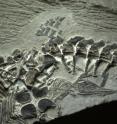Ancient reptile birth preserved in fossil
An ichthyosaur fossil may show the earliest live birth from an ancient Mesozoic marine reptile, according to a study published February 12, 2014 in PLOS ONE by Ryosuke Motani from the University of California, Davis, and colleagues. Ichthyosaurs were giant marine reptiles that evolved from land reptiles and moved to the water. Scientists report a new fossil specimen that belongs to Chaohusaurus (Reptilia, Ichthyopterygia), the oldest of Mesozoic marine reptiles that lived approximately 248 million years ago. The partial skeleton was recovered in China and may show a live birth. The maternal skeleton was associated with three embryos and neonates: one inside the mother, another exiting the pelvis-with half the body still inside the mother-and the third outside of the mother. The headfirst birth posture of the second embryo indicates that live births in ichthyosaurs may have taken place on land, instead of in the water, as some studies have previously suggested.
The new specimen may contain the oldest fossil embryos of Mesozoic marine reptile, about 10 million years older than those indicated on previous records. The authors also suggest that live births in land reptiles may have appeared much earlier than previously thought.
Dr. Motani added, "The study reports the oldest vertebrate fossil to capture the 'moment' of live-birth, with a baby emerging from the pelvis of its mother. The 248-million-year old fossil of an ichthyosaur suggests that live-bearing evolved on land and not in the sea."
Source: PLOS
Other sources
- Ancient reptile birth preserved in fossil: Ichthyosaur fossil may show oldest live reptilian birthfrom Science DailyThu, 13 Feb 2014, 18:00:25 UTC
- Amazing fossil captures ancient baby reptile's birthfrom CBC: Technology & ScienceThu, 13 Feb 2014, 17:30:21 UTC
- Amazing fossil captures oldest live birthfrom CBC: Technology & ScienceThu, 13 Feb 2014, 17:00:26 UTC
- Ancient reptile's birth fossilisedfrom BBC News: Science & NatureThu, 13 Feb 2014, 10:30:40 UTC
- Fossil Shows Ancient Reptiles Gave Birth Head-Firstfrom MSNBC: ScienceThu, 13 Feb 2014, 0:20:18 UTC
- Oldest Sea Monster Babies Found; Fossil Shows Reptiles Had Live Birthfrom National GeographicWed, 12 Feb 2014, 23:21:36 UTC
- Oldest Fossil of Reptile Live Birth Foundfrom Live ScienceWed, 12 Feb 2014, 23:20:22 UTC
- Ancient reptile birth preserved in fossilfrom PhysorgWed, 12 Feb 2014, 22:20:29 UTC
